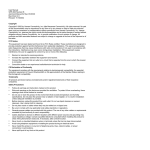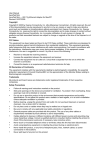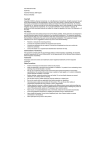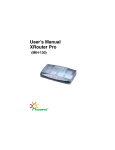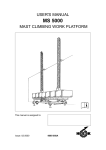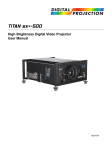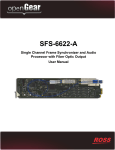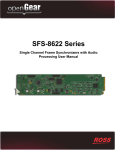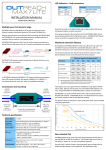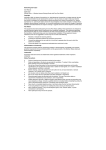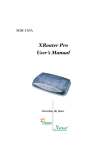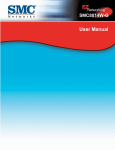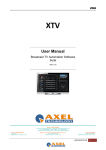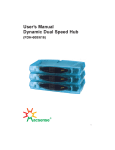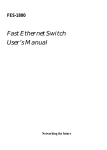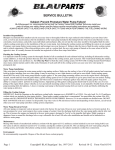Download Networking the Future User Manual
Transcript
Networking the Future PCMCIA AeroCard WPE-600 Wireless PCMCIA Card User Manual User Manual WPE-600 AeroCard — Wireless PCMCIA Card Copyright Copyright © 2001 by Xsense Connectivity, Inc. (dba Macsense Connectivity). All rights reserved. No part of this documentation may be reproduced in any form or by any means or used to make any directive work (such as translation or transformation) without permission from Xsense Connectivity, Inc. Xsense Connectivity, Inc. reserves the right to revise this documentation and to make changes in content without obligation among Xsense Connectivity, Inc. to provide notification of such revision or change. All products and their associated features are subject to change or upgrade at the time of the shipment or of the sales. FCC Notice This equipment has been tested and found to be FCC Rules certified. These restrictions are designed to provide protection against harmful interference from residential installations. This equipment generates radio frequencies that may cause interference with radio communications if not used in accordance with the instructions. Interference may even occur during proper installation. If this equipment causes interference, the user is suggested to correct it by one or more of the following: • • • • Reorient or relocate the receiving antenna. Increase the separation between the equipment and receiver. Connect the equipment into an outlet on a circuit that is separate from the one to which the receiver is connected. Consult the dealer or an experienced radio/television technician for help. CE Declaration of Conformity The equipment complies with the requirements relating to electromagnetic compatibility, the essential protection requirement of Council Directive/EEC on the approximation of the Member States relating to Electromagnetic compatibility. Trademarks All products and brand names are trademarks and/or registered trademarks of their respective companies. Safety Precautions • • • • • • • • • • • • Follow all warnings and instructions marked on the product. Slots and openings on the device are provided for ventilation. To protect it from overheating, these openings must not be blocked or covered. Do not use or store this product in the environment that exceeds temperature and humidity specifications. Do not place this product near a radiator or heat register, or in a built-in installation unless adequate ventilation is provided. Before cleaning, unplug this product from wall outlet. Do not use liquid cleansers or aerosol cleansers. Use a damp cloth for cleaning. Do not place cords or cables where they may be walked on or tripped over. Be sure to comply with any applicable local safety standards or regulations. General-purpose cables are provided with this product. The use of any other cables or requirements mandated by local authority is user’s responsibility. Cables attached to devices in different locations with different power sources and grounding may cause hazardous voltage. Consult a qualified electronic consultant before installing the product to check if this phenomenon exists and, if necessary, take corrective action. Never touch un-insulated telephone wires or terminals unless the line has been disconnected. Avoid using telephone equipment or installing the product during an electrical storm. Never install this product, or any kind of telephone jacks, lines, network cables, or power connections in wet locations. Never spill liquid of any kind on this product TABLE OF CONTENTS 1.0 INTRODUCTION ........................................................................................ 3 1.1 Benefits ................................................................................................... 3 1.2 Features .................................................................................................. 3 1.3 Introduction to Wireless Networking ........................................................ 4 1.4 Wireless Network Planning ..................................................................... 5 2.0 BEFORE YOU START................................................................................ 7 2.1 Package Overview .................................................................................. 7 2.2 System and Other Requirements ............................................................ 7 3.0 MACINTOSH SETUP ................................................................................. 9 3.1 Hardware Installation of AeroCard........................................................... 9 3.2 Macintosh Driver Installation ................................................................... 9 3.3 TCP/IP Configuration............................................................................. 10 3.3.1 MacOS TCP/IP Configuration ..................................................... 10 3.3.2 Assigning TCP/IP Values Manually ............................................. 10 3.4 AppleTalk Configuration......................................................................... 11 3.5 Using the AeroCard Control Panel ........................................................ 12 3.5.1 Connecting with a Base Station................................................... 12 3.5.2 Connecting with Peer-to-Peer ..................................................... 14 3.5.3 Encryption .......................................................................................... 14 4.0 WINDOWS SETUP................................................................................... 17 4.1 Hardware Installation of AeroCard......................................................... 17 4.1.1 Windows 95/98/ME Driver Installation......................................... 17 4.1.2 Windows 2000 Driver Installation ................................................ 17 4.2 Windows Driver Installation ................................................................... 18 4.2.1 Configuring the AeroCard for Windows 95/98/Me ....................... 18 4.2.2 Configuring the AeroCard for Windows 2000 .............................. 20 4.3 TCP/IP Configuration............................................................................. 20 4.3.1 Windows 95/98/Me TCP/IP Configuration ................................... 20 4.3.2 Windows 95/98/Me TCP/IP Manual Configuration ...................... 22 4.4 Configuration Utility Program ................................................................ 24 4.4.1 Installing the Configuration Utility Program ................................. 24 4.4.2 Uninstalling the Wireless LAN Card Software ............................. 24 4.5 Using the Configuration Utility ............................................................... 24 4.5.1 Link Info....................................................................................... 25 4.5.2 Configuration............................................................................... 26 4.5.3 Encryption ................................................................................... 28 4.5.4 About ........................................................................................... 30 5.0 TROUBLESHOOTING ............................................................................. 31 5.1 Common Problems and Solutions ......................................................... 31 5.2 Frequently Asked Questions ................................................................. 34 5.3 Glossary ................................................................................................ 35 APPENDIX ..................................................................................................... 39 1.0 INTRODUCTION Congratulations on purchasing the AeroCard, the Wireless LAN (WLAN) PCMCIA card for Mac and PC. Welcome to the Macsense/Xsense Networking Product Family. These days, business moves at lightning speed. To compete, companies must make it easy for their employees to share vital business intelligence real-time and to collaborate without restriction. But until now, network users have been bound by the limits of their wired network, and forced to settle for access only at their desk. A trend in the technology industry today is to eliminate the cable restrictions and hassle of wires by implementing a wireless network. By choosing wireless you reduce the hassle of cable clutter, the expensive need to run cabling in the home or office and the aggravation altogether to crawl under that desk for the last time to see if that Ethernet cable is connected. A WLAN standard called IEEE 802.11b has emerged delivering speeds of up to 11 Mbps and the ability to take the power of the Internet with you. Imagine the ease of which you can setup this wireless network providing roaming access to the Internet and your network. The combined flexibility of a laptop and our Wireless card can provide some impressive changes indeed. Surf the Net while sitting on the couch during the big Sunday game. Review your stock portfolio in bed. Maybe the kids want to chat with friends on AOL out by the pool. The convenience of where and when you want to connect to your network or Internet is now yours. 1.1 Benefits • Eliminates the hassle and cost of cabling. • Longer operating range gives you more room to move around. • Take advantage of wireless connectivity in cafes, airports, hotels, etc. • Supports most Apple PowerBooks and PC notebooks with a Type II PCMCIA slot. • WEP encryption provides the highest security. • Compatible with Apple AirPort Base Station and all 802.11b-compliant Access Points. • Lifetime Free Technical Support. • One-Year Warranty. 1.2 Features • Interoperable with IEEE 802.11b (DSSS) 2.4GHz-compliant devices. • Up to 900 feet operating range in open environment. • High-speed data transfer rate of 11, 5.5, 2 and 1 Mbps 3 • Auto-fallback to lower data rate in noisy environments. • WEP (Wired Equivalent Privacy) 40-bit and 128-bit data encryption for highest security. • Drivers support Windows 95/98/98SE/ME/NT4/2000, and Mac OS 9.x. • Advanced Power Management features conserve valuable computer battery life. • Supports computer-to-computer (ad-hoc) connection without an Access Point. • Works with all standard Internet applications. 1.3 Introduction to Wireless Networking There are basically two types of wireless networks: Infrastructure and Ad-hoc. An Infrastructure network uses one or more Access Points (such as the XRouter Aero) as a gateway, linking the wireless network to a wired LAN. As a result, portable workstations on your wireless network have access to all the features of your wired LAN including email, Internet access, network printers and file servers. 4 This is in contrast with another related wireless topology, called Ad-hoc network, in which each wireless workstation communicates with one another without the existence of an Access Point. Although Ad-hoc allows for wireless connection between computers without an Access Point or Wireless Router, it is Infrastructure with it’s central wireless Access Point or Broadband Router that will be the most common. 1.4 Wireless Network Planning Although the arrival of affordable wireless technologies has provided a great deal of flexibility in how you connect to the Internet, there still is some needed planning in setting up a WLAN network. A WLAN can in some respects be considered much like a wired network with the exception that wireless cards will transmit the data over radio frequency waves instead of within a shielded Ethernet cable. Because of this, the initial location of the Access Point or Wireless Router is extremely important. Situating the AeroCard so that it has the least amount of obstruction is highly advisable. The setup of all wireless devices involved is quite important, as they should share the same radio channel and ESSID. Without these common settings, they will not be able to communicate with one another. Any additional encryption settings for security measures must be configured identically on all devices to accept the data transfer. One of the greatest advantages of a wireless network is the ability to roam in an Infrastructure network. By creating multiple, yet overlapping wireless communities, or “cells” as the industry calls it, each with their own unique ESSID, you can allow for wireless roaming amongst clients. As you walk out of range from one Access Point, you will be detected and picked up by another, all the while connected to the network or Internet. This, however, does take proper and precise planning of where to locate your Access Points and how to overlap them so as to provide full wireless range. Some others points to follow when planning a wireless network: 5 1. 2. Minimize obstructions of the 802.11b RF waves a. Centrally locate the Wireless Router or Access Point. All obstructions will weaken the signal to some degree. b. Certain building materials (metals, concrete, etc.) should be avoided by the signal. Situate the wireless devices so as to maximize signal output and reception a. Situate the WLAN devices so the signal is going straight through the walls instead of at an angle. b. Stay clear (3 – 5ft.) of devices that introduce “noise” to the reception, such as microwaves, monitors, etc. c. Position the antenna to maximize RF signal output. d. Additional Access Points can be placed in areas of low or no signal reception. Note: The new 802.11b wireless protocol has limitations as to how far the wireless range can reach. Take your time to plan your wireless network properly to help provide the best range. Each obstruction can and will diminish the signal strength. So bare this in mind when planning and implementing your wireless network. 6 2.0 BEFORE YOU START 2.1 Package Overview • One Wireless AeroCard • One Driver and Utility CD-ROM • User Manual • Registration Card 2.2 System and Other Requirements • A 16-bit PCMCIA Type II slot • PCMCIA revisions 2.1 compliant card and socket services • Mac OS 9.x; Windows 95, 98, ME, NT 4.0, or 2000 • 500 Kbytes of free disk space for utility and driver installation 7 3.0 MACINTOSH SETUP AeroCard is compatible with the following Apple PowerBook models: • PowerBook 2400 • PowerBook 3400 • PowerBook G3 series (FireWire, Wall Street, Bronze Keyboard) • PowerBook G4 Titanium And with one vacant PCMCIA Type II slot and running Mac OS 9.x. We may support additional models in the near future so please check our website for the current list. 3.1 Hardware Installation of AeroCard 1. Insert the AeroCard into an available Type II PCMCIA slot with the label facing upward and the 68-pin connector facing into the slot. 2. Firmly push the card into the slot. Never force the card into the slot. A generic card icon will appear on the desktop, however, this will be replaced with the AeroCard icon once the drivers are properly installed. 3. To properly release the AeroCard from the computer, you must first turn “Off” the card. You can do this by opening both the TCP/IP and AppleTalk control panels and switch them to an alternate protocol, such as PPP. Then Close and Save the new settings and you will now be able to eject the card by dragging the AeroCard icon to the trash. Note: Always have the card facing correctly into the slot. Forcing the card into the slot upside down can damage the computer. 3.2 Macintosh Driver Installation You must first install the drivers before the OS will recognize the WPE-600 AeroCard. Supported operating systems are OS 9.x. Note: You may use the Extension Manager to turn “off” any other wireless card drivers, such as Apple Airport card drivers that may cause conflicts with our wireless card. Follow these simple steps to load the drivers properly: 1. Double-click the Installer icon and follow the steps. This will install the necessary drivers. 2. Restart the computer to load these drivers. To Disable Drivers: 1. Under the Apple Menu, go to Extensions Manager under Control Panels. 2. Uncheck the AeroCard Driver, AeroCard Enabler extensions and AeroCard control panel and restart the computer. 9 To Remove Drivers: 1. If AeroCard is currently in use, select another networking method other than “AeroCard PC Card” in the AppleTalk and TCP/IP control panels. Close the window and save the settings. 2. Then manually remove the AeroCard Control Panel and AeroCard Enabler and Driver extensions. 3.3 TCP/IP Configuration 3.3.1 MacOS TCP/IP Configuration The AeroCard utility has a TCP/IP and AppleTalk button to link to these control panels for proper configuration. You can either use these or open the control panel from within the Apple Menu. 1. Open the TCP/IP control panel. 2. In the Connect via menu select AeroCard PC Card. 3. In the Configure pull-down menu, select Using DHCP Server to allow the DHCP server on the network to dynamically assign IP addressing. If you do not have a DHCP Server, choose Manually and assign the IP addressing. 4. Close the TCP/IP window and save the changes. 3.3.2 Assigning TCP/IP Values Manually If you are assigning Manual IP addresses, then you must first have valid addresses before continuing. These might be provided by your ISP or Network Administrator. To manage the computer’s address manually, perform the following steps: 1. 10 In the Connect via menu select the AeroCard protocol installed in your computer. 2. In the Configure menu select Manually. a. In the IP Address field, enter the IP address provided by your network administrator or ISP. NOTE: No two computers on the LAN can have the same IP address or an IP address conflict will occur. Name Server addresses must be obtained from your ISP as we have only provided example addresses here. b. In the Subnet Mask field enter the valid address. c. In the Router Address field enter the valid address. d. In the Name Server Address field enter the DNS addresses in proper order provided by your ISP. If you do not have this information, call your ISP and ask for the Primary and Secondary Domain Name Server numbers. e. In the Search Domains field enter the domain information provided by your ISP. f. Close the TCP/IP window and save the changes. 3.4 AppleTalk Configuration AppleShare allows Macintosh computers to access one another’s drives over the network via the AppleTalk protocol. Both the AppleTalk and FileShare control panels must be configured properly to allow this. To access AppleShare to transfer files: 1. Verify that the AeroCard is selected in the AppleTalk control panel and it is associated with the Base Station. 11 2. Verify that File Sharing is turned “On” in both computers and that the proper resources have been shared for user access. 3. Select “Chooser” from the Apple menu and select AppleShare to view the available machines on the network. 4. Choose the appropriate server to transfer files. 5. Enter the proper username and password. 6. Click the “OK” button. The selected server should now mount to the desktop. You may access this mounted drive just like your own drive, with access only allowed to properly shared folders. 3.5 Using the AeroCard Control Panel The AeroCard is capable of two wireless networking topologies, Infrastructure and Ad-hoc. An Infrastructure network uses one or more Base Stations (such as the XRouter Aero or Apple Airport Base Station) as a gateway, linking the wireless network to a wired LAN. As a result, wireless workstations have access to all the features of your wired LAN including email, Internet access, network printers and file servers. This is in contrast with another related wireless topology, called Ad-hoc network, in which each wireless workstation communicates with one another without the existence of a Base Station. Note: Each wireless client must have the same ESSID as the Base Station or Adhoc network or they will not be allowed access to the wireless network. 3.5.1 Connecting with a Base Station ESSID All Base Stations in range will be listed in this pull-down window for operation. By switching between these Base Stations you can see the difference in the RF signal strength. Leaving the ESSID field empty and press Connect button will prompt AeroCard to choose the most appropriate Base Station which is typically the nearest. 12 To change the ESSID: The drivers support changing the ESSID on-the-fly. You can associate to a different Base Station by changing the ESSID. The re-association occurs immediately and does not require a reboot. 1. Open the AeroCard Control Panel. 2. Select an alternate Base Station using the pull-down option or simply type in the ESSID exactly as it is named. 3. Click Connect to save the changes. The ESSID, MAC Address and Signal Strength will change to reflect the new Base Station. Base Station MAC Address The MAC or Hardware Address of the Base Station presently in use is displayed here in Hex format. During wireless roaming the AeroCard will choose the nearest Base Station and will display the appropriate MAC Address. Signal Strength This will show the strength of the RF signal between the AeroCard and the Base Station. This is indicative of how strong or weak the connection is due to distance or interference such as walls, floors or other RF devices. If the signal reaches Minimum, you may begin to notice packet loss and connection problems. Reorientate either the PowerBook or Base Station for better reception. TCP/IP This button opens the TCP/IP control panel for proper configuration. AppleTalk This button opens the AppleTalk control panel for proper configuration. Connect This will save your configuration settings and connect you to the Base Station chosen. 13 3.5.2 Connecting with Peer-to-Peer In an Ad-hoc network, each wireless workstation communicates with one another without the existence of an Base Station. To create an Ad-hoc network, all computers must share the same ESSID and channel. Appletalk must be active and AeroCard is chosen in the Appletalk control panel as well as the FileSharing control panel turned “On”. To enable Ad-hoc: 1. Click the box next to Enable Ad-hoc. 2. Input the proper ESSID (case sensitive). 3. Choose the correct Channel. 4. Click Connect to save settings. Note: In Ad-hoc mode, the ESSID field and signal strength will be deactivated. 3.5.3 Encryption WEP (Wired Equivalent Privacy) A data privacy encryption method based on a 40-bit shared key algorithm. Note: With WEP encryption, 64-bit encryption is basically 40-bit key auto-translated to 64-bit before being transmitted. To enable encryption: 1. Click the Enable Encryption box. 2. Choose either 40-bit or 128-bit. 3. Choose one of the four available keys and input a unique HEX key. 4. Click OK and then Yes to save the settings. 14 This HEX key must be identical on all wireless devices to allow for proper communication. 15 16 4.0 WINDOWS SETUP 4.1 Hardware Installation of AeroCard 1. Insert the AeroCard into an available Type II PCMCIA slot with the label facing upward and the 68-pin connector facing into the slot. 2. Firmly push the card into the slot. Never force the card into the slot. 3. To properly release the AeroCard from the computer, you must first turn “Off” the card. You can do this with either the PC Card (PCMCIA) Status icon in the tool bar or by opening the PCMCIA Control Panel. Then click Stop. NOTE: Always have the card facing correctly into the slot. Forcing the card into the slot upside down can result in severe damage to the computer. 4.1.1 Windows 95/98/ME Driver Installation Windows automatically detects new hardware and will prompt for a driver to be installed. Note that there are minor differences in the screen shots and instructions but that the OS will basically walk you through the setup with the hardware wizard. If this wizard doesn’t show up, then open the “Add/Remove Hardware” Control Panel to begin. 1. With the Driver CD already loaded, insert the AeroCard. Windows will detect the card and search for but will not find the driver. 2. Click Next when prompted then choose Search for the best driver for your device to find the necessary driver. Click Next. 3. On the Specify a location screen, click the Browse button to locate the driver CD and after selecting the correct driver folder, click OK. 4. This will return you to the Location of driver screen with the folder listed. If the correct folder is listed, click Next. 5. Windows may need files from the original OS CD. In this case, insert the CD and follow the on-screen instructions to copy the necessary files to the computer. If you are not prompted for these files, then continue with the next step. 6. Click Finish to begin the installation. When prompted, restart the computer. The driver will now be installed. 4.1.2 Windows 2000 Driver Installation 1. With the AeroCard inserted, Windows will automatically detect the new hardware and prompt you to install the proper driver. Be sure to have the Driver CD inserted into the CD-ROM. Click Next on the Welcome screen. 2. Select Search for a suitable driver... and click the Next button. Windows 2000 will now search for the driver. 3. Select Specify a location and click Next. 17 4. Windows will now search for the driver. Click the Browse button and navigate to the proper driver in the OS folder on the CD. Then click Next. 5. If the Digital Signature Not Found screen appears do not be alarmed as there is no problem. Simply click Yes to continue with the install. 6. Windows will now install the necessary driver files. Click the Finish button when prompted. Windows may prompt you for necessary files from your Windows 2000 CD. Insert your Windows 2000 CD if requested. The installation is now complete. Continue on to the Configuring the AeroCard for Windows 2000. 4.2 Windows Driver Installation 4.2.1 Configuring the AeroCard for Windows 95/98/Me After installing the AeroCard, Windows 95, 98, or Millennium will automatically identify the card. Next, you will need to configure the AeroCard driver software. 1. After installing the AeroCard, the Prism adapter screen (shown below) may automatically come up. If it does not appear automatically, click on the Start button, choose Settings and then Control Panel. Double click on the Network icon and choose the Prism adapter. Click the Properties button, and then choose the Advanced tab. Select Authentication Algorithm from the list provided and select a Value from the drop down menu on the right. As indicated, you should always use WECA Compliant unless you have some other reason to do so. Choose Channel to continue or the OK button to finish. If you choose to finish now, continue to the Installing Network Protocols section. NOTE: For the easiest way to configure your AeroCard, please refer to the Configuration Utility section. 18 2. Select Channel from the list provided and select a Value, from the drop down menu on the right, between 1 and 11. This Channel must be the same for all wireless devices on your network. Click Network Type to continue or the OK button to finish. If you choose to finish now, continue to the Installing Network Protocols section. 3. The Fragmentation Threshold Value indicates how much of the network resources are devoted to recovering packet errors. The value should remain at its default setting of 2,432. If you experience high packet error rates, you can increase this value, but it will likely decrease overall network performance. Only minor modifications of this value are recommended. Click Network Type to continue or the OK button to finish. If you choose to finish now, continue to the Installing Network Protocols section. 4. Select Network Type and select a Value, from the drop down menu, of either 802.11b Ad-Hoc, Ad-Hoc, or Infrastructure. The Infrastructure mode allows a wireless adapter to communicate with a wired network employing an Access Point, while the Ad-Hoc modes allow wireless-to-wireless, peerto-peer communication. 802.11b Ad-Hoc is for connecting with other Wireless Adapters that comply with the 802.11b standard. Click Power Save Mode to continue or the OK button to finish. If you choose to finish now, continue to the Installing Network Protocols section. 5. Select Power Save Mode and select either Enabled or Disabled for a Value. Disabled will allow for uninterrupted data communication. Selecting Enabled allows your notebook to enter “sleep” mode and could interrupt data communication. For further information about Power Save Mode, see the chapter entitled Configuration Utility. Click Preamble Mode to continue or the OK button to finish If you choose to finish now, continue to the Installing Network Protocols section. 6. A preamble is a signal used to synchronize the transmission timing between two or more systems. A series of transmission pulses is sent before the data to indicate that "someone is about to transmit data". This ensures that systems receiving the information correctly interpret when the data transmission tarts. The Preamble mode should be set to Long if in a “noisy” network environment), Short (if the environment is clear), or Auto (to let the card interpret the environment). Click OK to finish and continue to the Installing Network Protocols section. 7. The RTS Threshold Value should remain at its default setting of 2,432. Should you encounter inconsistent data flow, only minor modifications are recommended. Click ESSID to continue or the OK button to finish. If you choose to finish now, continue to the Installing Network Protocols section. 8. The Value for ESSID depends on what Network Type selected in item 2. (ESSID is also commonly known as ESSID.) If the Network Type you have chosen is "Infrastructure", it should have the same ESSID or ESSID 19 name as the Access Point. If the Network Type is "Ad-Hoc", all clients should share the same ESSID name. Click Use WEP to continue or the OK button to finish and continue to the Installing Network Protocols section. 9. Select either Disabled, 40 bit, or 128 bit as the Value under Use WEP. Wired Equivalent Privacy (WEP) is an encryption scheme used to protect wireless data communication. The Disabled setting prevents the sharing of data with other computers on a WEP Network. For data sharing to be enabled, select either 40 or 128 bit encryption, depending on your needs. For further information, see the Configuration Utility section of this guide. Once your card is configured, click OK and continue. 4.2.2 Configuring the AeroCard for Windows 2000 After installing the AeroCard, Windows 2000 will automatically identify the card. Next, you will need to configure the AeroCard’s driver software. 1. From the Start Menu, select Settings and bring up the Control Panel. From the Control Panel, double-click the Network and Dial-Up Connections icon. 2. At the Network and Dial-Up Connections screen, double-click the Local Area Connection ## icon. (The number on this icon will vary with your computer.) 3. The General Local Area Connection Status screen will show the status of the AeroCard connection. Click the Properties, button to continue. 4. On the Properties screen, click the Configure button to configure your card. 5. The next screen that you will see will be the General tab. This will give you information on the status of the AeroCard. Click the Advanced tab to configure your card. 6. From this point forward, the configuration of the card is the same as for Windows 95, 98 and Me. Follow the instructions provided in the Configuring the AeroCard for Windows 95, 98, and ME section. 4.3 TCP/IP Configuration Part of the process of enabling communication involves setting the IP address for the computer. The client computer must have the IP address configured such that it shares the same subnet-numbering scheme, as the network. We will explain this in more detail later in the chapter. Configuring the IP address is a simple task that can be performed through your computer’s TCP/IP control panel. We have provided instructions for the configuration process for PC users. Find the appropriate set of instructions in the following pages. 4.3.1 Windows 95/98/Me TCP/IP Configuration 1. 20 Double-click the Control Panel icon in My Computer folder or locate it in the Start Menu. The sub-folder Control Panel is located under Settings. 2. In the Control Panel, double-click the Network icon. The network interface card (installed on your computer) appears along with the network protocol on the Configuration list. 3. Double-click TCP/IP protocol on the list. If TCP/IP does not appear on the list, you must install the TCP/IP protocol first as illustrated in step 4. Clients with TCP/IP already installed may skip to step 5. 4. To install the TCP/IP protocol: a. Keep your copy of Windows 95/98/Me CD-ROM on hand. (You will need it for this installation.) b. Click the Add button from the Configuration list of the Network window. A new window appears. c. Double-click Protocol. Then, in the Select Network Protocol window, choose Microsoft on the Manufacturers list, and select TCP/IP on the right side of the list. Follow the instructions on the screen to complete the installation process. It should prompt for a restart and then follow on with step 5, as you will now find a TCP/IP Protocol in your Network control panel for your wireless adapter card. 5. After double-clicking the installed TCP/IP protocol, the TCP/IP Properties window appears. To automatically assign a computer’s TCP/IP, perform the following functions: a. Click the IP Address tab from the TCP/IP Properties window. b. Select the item Obtain IP address automatically to allow the network DHCP server, such as the XRouter Aero, to assign an IP address and other TCP/IP configuration information to the client automatically. 21 c. After specifying the settings of TCP/IP click OK and restart Windows to allow the settings to take effect. 4.3.2 Windows 95/98/Me TCP/IP Manual Configuration To manage a computer’s address manually, perform the following steps: Click the IP Address tab from the TCP/IP properties window. 1. Select the item Specify an IP address to allow the user to manually input a unique IP address and Subnet Mask. (See Figure 5.1-4) 2. In the IP Address field enter “192.168.1.x” where x is any variable of your choice ranging from 2 to 253. Enter “255.255.255.0” in the Subnet Mask field. 22 NOTE: No two computers on the LAN are allowed to adopt the same IP address or an IP address conflict will occur. 3. Click the Gateway tab and enter the Private IP Address of your router in the Gateway IP address field and click Add. The Gateway IP address value must be the same as the network router’s IP address to keep the proper IP numbering scheme. 4. Click the DNS Configuration tab, choose Enable DNS and input a unique Host Name that simply is the computer’s name on the network. Enter the DNS IP addresses provided by your ISP in the proper order into the DNS Server Search Order field and click Add. 23 5. Click OK to close out of both windows and you will be prompted to restart the computer to activate these changes. 4.4 Configuration Utility Program An easy-to-use management utility is provided for your AeroCard. This chapter details the installation and usage of this utility. 4.4.1 Installing the Configuration Utility Program 1. Insert the driver CD that accompanied your AeroCard. 2. Open the CD and double-click on the Setup icon. 3. The Welcome Screen for the Install Wizard will pop-up and will walk you through the management utility installation. You will need to know the wireless network ESSID and which mode, Ad-hoc or Infrastructure. 4. Choose to restart your computer when prompted. Note: You cannot have two Configuration Utilities installed at the same time. You will be prompted to uninstall the old utility before continuing a new install. Once installed, this utility will be represented by an icon in your tool bar. You can also open the utility by going to Startup Menu. The icon in the tool bar indicates signal strength by three colors: • Green– strong signal • Yellow– standard signal • Red– poor connection 4.4.2 Uninstalling the Wireless LAN Card Software If you need to uninstall the Wireless LAN Card and application software for any reason, complete the following steps: 1. Close all programs that are currently running. 2. Remove the Wireless LAN Card from the computer. 3. Click the Windows Start button, point to Programs, PRISM 802.11and then click Uninstaller. 4. Click Yes to proceed with the software procedure. When the un-installation is completed, click OK. 4.5 Using the Configuration Utility Now that after the management utility is installed properly you can begin to configure the AeroCard. Be sure to have the card inserted during configuration. Once you open the utility you will notice that there are four tabs: Link Info, Configuration, Encryption and About. The main tab for configuration of your AeroCard will be Configuration but all four will be explained. 24 Note: Always use the Configuration Utility to configure your AeroCard as opposed to going into your Network Control Panel to do so. 4.5.1 Link Info Link Quality and Signal Strength won’t show up when the card is configured in Ad-hoc. State This field will show the current status of the wireless adapter. Associated means the adapter is linked to a wireless “cell” or “BSS”(Basic Service Set ID) and is able to join the existing network. A status of “Not Linked” means that the node is “Scanning” to search for an access point within range. An error message will display if the driver cannot initialize. Rescan Clicking the Rescan button commands the driver to begin a new Connection Session that acts different according to which driver mode is selected. • Infrastructure Mode - All available channels will be scanned continuously until an existing Access Point is found with a matching BSS ID. It will then proceed with authentication to associate with the found Access Point. • Ad-hoc Mode - The driver scans for five seconds searching for an available Ad-hoc network, but will start its own Ad-hoc network if one is not found. Current Channel Displays the current channel for the active wireless connection. During “Scanning”, this value has no relevance. Current Tx Rate Current Tx Rate field displays the transfer rate in megabits per second. Throughput 25 These two fields display the instantaneous wireless Receive and Transmit throughput displayed as measured in bytes per second. Values are updated every two seconds. Link Quality The Link Quality bar indicator is only active when the driver is in Infrastructure Mode. The link between the computer and Access Point is measured by Link Quality. The different rating levels of link quality: • “Not Connected” • “Poor” 0 - 29 • “Fair” 29 – 59 • “Good” 60 - 89 • “Excellent” 90 - 100 As “cells” must overlap to allow for wireless roaming, the AeroCard will look for another Access Point when the driver receives a link quality rating of “Poor”. Link Quality is a measure of receive and transmit errors over the radio. Signal Strength The Signal Strength bar indicator is only active when the driver is in Infrastructure Mode. The bar graph displays normalized signal strength as reported by the radio, averaged over all frames over 100 bytes long that are received from the Access Point. 4.5.2 Configuration The Configuration tab contains the majority of the operating parameter settings for the AeroCard. Here, you will perform most of the changes needed to adapt to different wireless networks. Changes can be applied with rebooting your computer. Mode This field allows you to select from a list of supported Network “Modes”. The modes displayed will depend on the type of installation that was performed. If an Access Point was installed then mode will only display “AP”. If a Client installation was done, then Mode will have two values: “Ad-hoc” and “Infrastructure”. • Ad-hoc - This is the 802.11 peer-to-peer mode of operation. Only one wireless “cell” is supported for each different ESSID while in Ad-hoc mode. Client computers communicate directly with one another with no Access Point operating to conduct traffic. • Infrastructure – An 802.11 compliant Access Point conducts the packet traffic on the network in this mode. Both wireless and wired computers are involved in the BSS. Note: When in Ad-hoc mode, Link Quality and Signal Strength indicators will not be available. 26 ESSID Similar to domains in Windows NT, the Service Set Identifier (Wireless Network Identifier) is the group name that will be shared by every member of your wireless network. Your client ESSID must match with that of the “Access Point” to be a member of the wireless cell. The ESSID can be any text string of alphanumeric characters including spaces up to 32 characters long. We highly recommend setting the ESSID as a unique identifier so as to not have two wireless networks sharing the same ESSID. To allow for wireless roaming, multiple Access Points must be placed so as to overlap and all Access Points and wireless clients must share the same ESSID. Tx Rate Set to the default of “Fully Automatic”, this setting allows the user to set a particular connection rate at which any client cannot go above. PS Mode Present only when the Mode is set to either Infrastructure or Ad-hoc, Access Points, by nature, do not save power consumption. • Disabled – power consumption is not an option • Enabled – periodically, particular areas of the radio hardware are turned off An 802.11 Access Point automatically buffers data frames for all Power Save computers and will only send the frames if the node “Polls” for its data or indicates that it is no longer in Power Save Mode. Channel Here, the user has the ability to configure the AEROCARD for up to eleven different radio frequency channels. Only Access Points and Ad-hoc computers can establish a wireless cell so there is no option for this in Infrastructure mode, as they simply choose the channel of their Access Point. If you desire to have an Ad-hoc network use a particular channel, then all computers in the Ad-hoc network should set this parameter to the same value, since you cannot control which member of the Ad-hoc network powers up first and thus starts the BSS. Subsequent Ad-hoc computers will join the existing BSS on whatever channel it happens to be on. Only valid channels belonging to the Regulatory Domain indicated by the radio hardware will be displayed and/or allowed. 27 Restore Defaults: Pressing this button restores each field in the panel to its original default value. The Apply Changes button or OK must be pressed before the default values are saved to the driver and registry. Undo Changes: Pressing this button reverts all fields in the panel back to their original values that were present when the Configuration Utility was opened from the Task Bar. Apply Changes: This button becomes active only when one of the fields has been modified. Pressing this button applies the changed values to the driver and saves them to the registry for the next time the PC boots up. 4.5.3 Encryption WEP uses a 40-bit key to provide access control to your network and encryption security for every data transmission. To decode a data transmission, each point in a network must use an identical 40-bit key. When using 40-bit encryption, remember that it is identical to and compatible with 64-bit encryption, but not with 128-bit. Higher encryption levels mean higher levels of security, but, due to the complexity of the encryption, they may mean decreased network performance. You may desire an additional measure of security on your wireless network, which can be achieved by using WEP (Wired Equivalent Privacy) encryption. WEP encrypts each frame transmitted from the radio using one of the Keys entered from this panel. When an encrypted frame is received it will only be accepted if it decrypts correctly. This will only happen if the receiver has the WEP Key used by the transmitter. The 64 Bit and 128 Bit WEP keys can be generated from a user-defined Passphrase or entered manually. Note: Please make sure that each point in your wireless network is set at an identical WEP value. 28 Pass-Phrase Alternatively a Pass-phrase can be entered which is used as a “constant variable” to randomly generate the four keys. This saves considerable time since the same keys must be entered into each node on the wireless network. The Pass-phrase can be any text string with a maximum of 31 alphanumeric characters and is strongly recommended because it is the easiest way to generate WEP keys. To enable WEP and generate a valid encryption key: 1. Choose 64 Bit or 128 Bit in the pull-down menu. 2. Type the exact, case-sensitive Pass-phrase into the field. 3. Click the “Apply Changes” button to generate the four keys. 4. Click “OK” to finish. Note: The WEP key must be the same for both the sending and receiving machines. (Although you may need to enter keys manually to satisfy the needs of your particular network, we recommend implementing the Pass-phrase feature when you can for simplicity. Check encryption settings on other computers to verify that your settings are correct.) Key 1 through Key 4 These four fields can be used to manually enter the keys. This may be necessary if you wish this node to match keys in a different vendor’s product. These fields also display the keys when they are generated using a Pass-phrase. Default Tx Key This pop-up field sets which of the four keys will be used by the driver to encrypt frames it will be transmitting. This field does not affect decryption, as the driver can decrypt any frame that it receives which was encrypted with one of the four keys. 29 Note: The 128-bit encryption is limited to only one key and therefore, the Default Tx Key is not available. Apply Clicking Apply will save the newly generated keys in the driver registry until they are replaced. Note: Please make sure that each point in your wireless network is set at an identical WEP value. WEP 64-bit encryption is not upward compatible with 128-bit devices. 4.5.4 About The About screen shows the release information for the Driver Version, Configuration Utility Version and Firmware Version. 30 5.0 TROUBLESHOOTING This chapter provides solutions to problems that may occur during the installation and operation of the AeroCard. Check the following symptoms and their possible causes before contacting Xsense Tech Support. Read the description below to solve your problems. If you can’t find an answer here, check the Macsense/Xsense website at www.macsense-usa.com. 5.1 Common Problems and Solutions My PowerBook can’t see other computers in AppleShare. • Verify that AppleTalk is “active” and the AeroCard is chosen and that File Sharing is configured properly. • Double-check the other computer as well and make sure that both computers are using the exact settings for ESSID and Encryption. My PowerBook doesn’t recognize the AeroCard. • Verify that the AeroCard is firmly inserted into the PCMCIA slot. • Verify whether the AeroCard shows in either TCP/IP or AppleTalk. • Check to see if the drivers are loaded properly. • Re-install the drivers and re-insert the AeroCard. My computer does not recognize the AeroCard. • Verify that the AeroCard is properly inserted into the PCMCIA slot. The card should be inserted with the sticker facing upward and the antenna portion facing outward. • Verify that the drivers are loaded properly. The AeroCard does not work properly. • Reinsert the AeroCard into your notebook’s PCMCIA slot. A beep should be heard if the adapter is properly inserted. • For Mac environments, make sure that a PCMCIA card service driver is installed in your computer. • Open the PC Card Control Panel. If the card is detected, it should be listed here and is working properly. If you see a yellow question mark, the resources are conflicting. Right click on My Computer and select Properties. Select the device manager and click on the Network Adapter. You will find the AeroCard if it is installed successfully. If you see the yellow exclamation mark, the resources are conflicting. Click on PCMCIA card and then on PCMCIA card service. You will see the status of the AeroCard. If there is a yellow question mark, please check the following: Tips to follow if the card isn’t working properly: • Does your notebook support a 3.3V card? • Does your notebook have a free IRQ (PC only)? 31 • Did you install the card and driver correctly? If the AeroCard does not function after attempting the above steps, remove the card and do the following: • Uninstall the driver software. • Restart your laptop/PowerBook and repeat the hardware and software installation steps as specified in this User Manual. While in Infrastructure Mode, I cannot communicate with the other computers connected via Ethernet. • Verify that the Notebook/PowerBook with the AeroCard is turned on. • Verify that your AeroCard is communicating over the same channel and with the same WEP security settings as the other computers in the Infrastructure. I suspect the AeroCard is disrupted by interference. You may be able to eliminate any interference by trying the following: • Reseat the Wireless LAN Card. • Increase the distance between the wireless computers and the device causing the radio interference. • Plug the computer equipped with the Wireless LAN Card into an outlet on a different branch circuit from that used by the affecting device. • Keep the computer with the Wireless LAN Card away from the microwave oven, power supplies and large metal objects. • Consult the dealer or an experienced radio technician for help. The AeroCard is not detected. If the Wireless LAN Card is not detected by Windows, try the following: • Incorrect ESSID. Make sure the ESSID is the same for all computers that have a Wireless LAN Card. • Changes are not being recognized by your computer. Restart your computer. • If in Ad-hoc mode, make sure the Log on to Windows NT domain check box is not selected in the Client for Microsoft Networks Properties dialog box in the Network Configuration tab. • Incorrect IP Address or Subnet Mask. Check these settings in the TCP/IP Properties dialog box in the Network Configuration tab. • Make sure the channel for the Wireless LAN Card is set to the same channel number as the one for the other Wireless LAN card you are trying to connected to. Cannot connect to another wireless LAN card. If you cannot make a connection to another Wireless LAN Card from your computer, it could be due to one of the following reasons: • 32 Make sure the Wireless LAN Card is properly inserted in the PCMCIA slot. • Make sure the PCMCIA slot in your computer is working. • Contact your dealer for additional testing if there is a hardware problem with the Wireless LAN Card or call our Technical Support line. 33 5.2 Frequently Asked Questions Can applications be run from a remote computer over the wireless network? The application itself must support running over the network. Can I play computer games with other members of the wireless network? The game must support multiple players over a LAN (local area network). What is IEEE 802.11 standard? The IEEE 802.11 WLAN standards subcommittee is developing this standard for the industry. The objective is to enable WLAN hardware from different manufacturers to communicate. The 802.11 and 802.11b specifications apply to wireless Ethernet LANs, and operate at frequencies in the 2.4-GHz region of the radio spectrum. What IEEE 802.11 features are supported? The product supports the following IEEE 802.11 functions: • CSMA/CA plus Acknowledge protocol • Automatic Rate Selection • Multi-Channel Roaming • Power Management • RTS/CTS feature • Fragmentation Can Wireless products support printer sharing? Wireless products perform the same function as LAN products. Therefore, Wireless products can work with Windows NT/2000, or other LAN operating systems to support printer or file sharing. What is DSSS? What is FHSS? And what are their differences? Frequency-Hopping Spread-Spectrum (FHSS) uses a narrowband carrier that changes frequency in a pattern that is known to both transmitter and receiver, but not an unintended receiver. Direct-Sequence Spread-Spectrum (DSSS) generates a redundant bit pattern for each bit to be transmitted. Even if one or more bits in the chip are damaged during transmission, statistical techniques embedded in the radio can recover the original data without -the need for retransmission. To an unintended receiver, DSSS appears as low power wideband noise and is rejected (ignored) by most narrowband receivers. Would the information be intercepted while transmitting on air? WLAN features two-fold protection in security. On the hardware side, as with Direct Sequence Spread Spectrum technology, it has the inherent security feature of scrambling. On the software side, WLAN series offer the encryption function (WEP) to enhance security and Access Control. Users can set it up depending upon their needs. 34 5.3 Glossary Access Point An internetworking device that seamlessly connects wired and wireless networks. Access Points combined with a distributed system support the creation of multiple radio cells that enable roaming throughout a facility. In Macintosh terms, Access Point is also referred to as Base Station. Ad-hoc An ad-hock network is a local area network or other small network, such as wireless, in which some of the network devices are part of the network only for the duration of a communications session. In the case of mobile and portable devices, they can be a part of the network when in close proximity to the rest of the network. BSS ID (Basic Service Set) BSS Basic Service Set. A set of stations controlled by a single coordination function. Cable Modem A device that connects your PC to a local TV line and receives data at 1.5Mpbs. One of its connections is connected to your PC and the other one is to the cable wall outlet. It attaches a standard 10BASE-T Ethernet card to a computer and modulates between digital and analog signals. Cell The radio coverage area for a wireless device to communicate with a base station. The size of the cell can depend on the antenna, the speed of transmission, and the physical area. Channel Each channel refers to a different frequency level allowing for multiple communication paths through one device, much the same way a radio operates. ESS ID (Extended Service Set) One of three IEEE 802.11 basic topology schemes. ESS WLAN configurations consist of multiple BSS cells that can be linked by either wired or wireless backbones. IEEE 802.11 supports ESS configurations in which multiple cells use the same channel, and configurations in which multiple cells use different channels to boost aggregate throughput. Dynamic IP address A dynamic IP address is an IP address that is given out automatically from a DHCP Server to client computers or routers on a LAN or WAN. Gateway An entrance to a network. It associates with both router and switch whereas the router gives direction as data arrives at the gateway and the switch, on the other hand, furnishes its actual path in and out of the gateway. 35 IEEE Abbreviation of Institute of Electrical and Electronics Engineers. Founded in 1884, the IEEE is an organization composed of engineers, scientists, and students. The IEEE is best known for developing standards for the computer and electronics industry. In particular, the IEEE 802 standards for local area networks are widely adopted. IEEE 802.11 Standard In WLAN technology, 802.11 refers to standards set by the Institute of Electrical and Electronics Engineers. There are three specifications in the family, 802.11, 802.11a and 802.11b. 802.11 and 802.11b refer to wireless Ethernet LANs and operate at frequencies around the 2.4 GHz range. 802.11 generally have data speeds of 1 or 2 Mbps while 802.11b can have speeds of 5.5 or 11 Mbps. 802.11b can also realize speeds up to 20 Mbps. 802.11a refers to wireless ATM systems and operates at frequencies between 5 to 6 GHz. Infrastructure This type of network is a wireless or other type of small network where the wireless network devices are made a part of the network through the use of an Access Point. The Access Point connects the device to the rest of the network. IP Address An identifier for a computer or device on a TCP/IP network. Networks using the TCP/IP protocol route messages base on the IP address of the destination. The format of an IP address is a 32-bit numeric address written as four numbers separated by periods. Each ranges from 0 to 255. For example, 157.124.10.1 could be a valid IP address. ISM band The FCC and their counterparts outside of the U.S. have set aside bandwidth for unlicensed use in the ISM (Industrial, Scientific and Medical) band. Spectrum in the vicinity of 2.4 GHz, in particular, is being made available worldwide. This presents a truly revolutionary opportunity to place convenient high-speed wireless capabilities in the hands of users around the globe. ISP (Internet Service Provider) An organization that provides access to the Internet. Small ISPs provide service via modem and ISDN while the larger ones also offer private line hookups (T1, fractional T1, etc.). LAN (Local Area Network) A computer network that spans a relatively small area. Most LANs are confined to a single building or a group of buildings. However, one LAN can be connected to other LANs over any distance via telephone lines and radio waves. A system of LANs connected this way is called a wide-area network (WAN) MAC Address (Media Access Control Address) On a network, it is a unique 48-bit number used in Ethernet data packets to 36 uniquely identify an Ethernet device, such as an Ethernet adapter. Optional WEP40 A variation of WEP 40 that allows for the receipt and transmission of both WEP 40 encrypted packets and non-encrypted packets. PCMCIA (Personal Computer Memory Card International Association) This Association develops standards for PC cards, formerly known as PCMCIA cards. These cards are available in three types, and are about the same length and width as credit cards. However, the different cards range in thickness from 3.3 mm (Type I) to 5.0 mm (Type II) to 10.5 mm (Type III). These cards can be used for various functions, including memory storage, landline modems, and wireless modems. Protocol A set of rules that end points in a telecommunication use as they communicate. These end points must recognize and observe the protocol in the communication. Radio Frequency Terms: GHz, MHz, Hz —The international unit for measuring frequency is Hertz (Hz), equivalent to the older unit of cycles per second. One megahertz (MHz) is one Million-Hertz. One gigahertz (GHz) is one Billion-Hertz. The standard U.S. electrical power frequency is 60 Hz, the AM broadcast radio frequency band is 0.55–1.6 MHz, the FM broadcast radio frequency band is 88–108 MHz, and wireless 802.11 LANs operate at 2.4GHz. Roaming The ability to use a wireless device and move from one access point’s range to another access point without a drop or loss of connection. Shared Key Algorithm In encryption, both the sender and the recipient use the same secret key to both encode and decode a message. Spread Spectrum Spread Spectrum technology is a wideband radio frequency technique developed by the military for use in reliable, secure, mission-critical communications systems. It is designed to trade off bandwidth efficiency for reliability, integrity, and security. In other words, more bandwidth is consumed than in the case of narrowband transmission, but the trade off produces a signal that is, in effect, louder and thus easier to detect, provided that the receiver knows the parameters of the spread-spectrum signal being broadcast. If a receiver is not tuned to the right frequency, a spread-spectrum signal looks like background noise. SSID (Service Set ID) A group name shared by every member of a wireless network. Only client PCs with the same SSID are allowed to establish a connection. 37 Static IP address A static IP address is an IP address that does not change and is manually set in client computer or router in a LAN or WAN. TCP/IP Acronym for Transmission Control Protocol/Internet Protocol, the basic protocol of the Internet, which can be used as a communications protocol in a private network. Every computer that has direct access to the Internet has a copy of the TCP/IP program. TCP/IP uses the client/server model in which the user is the client that requests and is provided service by another computer, which is the server on a network. HTTP, FTP, Telnet, SMTP and other protocols are often packaged with TCP/IP as a “suite” in order to get to the Internet. URL A URL (Uniform Resource Locator) is the address of a file (resource) accessible on the Internet. The URL contains the name of the protocol required to access the resource, a domain name that identifies a specific computer on the Internet, and a hierarchical description of a file location on the computer. WLAN A WLAN in which a user can connect to a network using a wireless connection. IEEE 802.11 specifies the technology for WLANs, as well as the Wired Equivalent Privacy algorithm encryption method. WEP (Wired Equivalent Privacy) A data privacy encryption method based on a 64-bit shared key algorithm. WEP Key A form of security and encryption used for WEP. It is a special sequence of characters used to restrict access to a wireless network. WEP40 A 40-bit encryption method that secures data packets over an insecure path, such as the Internet, whereby the recipient must use a matching 40-bit key to decrypt the data. 38 APPENDIX SPECIFICATIONS: Frequency Band: 2400-2483.5 MHz (subject to local regulations). Number of Selectable Channels: 11 (USA and Canada) Modulation Technique: Direct Sequence Spread Spectrum (DSSS); CCK (11Mbps, 5.5Mbps), DQPSK (2Mbps), DBPSK (1Mbps). Spreading: 11-chip Barker sequence Media Access Protocol: CSMA/CA (Collision Avoidance) with ACK Security: 40-bit, 128-bit WEP Encryption Interface: PCMCIA Type II 3.3V Visible Indicator: One Red LED for Power Indication, One Green LED for Transmission Activity Antenna Type: 1 Internal On-board 3D Antenna Frame Error Rate (FER): Less than 8% Receiver Sensitivity (FER<8%): -80dBm@11Mbps (Normal temperature) Available Distance: 11 Mbps Open Space 5.5 Mbps 2 Mbps 1 Mbps 984ft/300m 1476ft/450m 1969ft/600m 2133ft/650m Semi Open Space 197ft/60m 263ft/80m 329ft/100m 394ft/120m Closed Space 115ft/35m 148ft/45m 197ft/60m 197ft/60m Average Output Power: 10dBm Average Power Consumption: RX mode: 200mA; TX mode: 270mA Operation Temperature Range: 32-131°F (0-55°C) 80% max. humidity (no condensation) Storage Temperature Range: 14-149°F (10-65°C) 80% max. humidity (no condensation) allowed) OS Compatibility: Windows 95/98/98SE/ME/NT4/2000; Mac OS 9.x Supported PowerBook Models: PowerBooks 2400 and higher with PCMCIA slot. Electromagnetic Emission: FCC Class B; CE Mark Commercial. Standards & Interoperability: IEEE 802.11b, Wi-Fi of WECA Dimensions (LxWxH): 4 5/8 x 2 1/8 x 1/2 in. (118 x 54 x 11 mm) Weight: 1.6oz (46g) 39 XSENSE STANDARD LIMITED WARRANTY Xsense warrants the product against any defects in manufacturing for the warranty period. If you require warranty service, be sure to have your proof of purchase and a barcode from the product packaging on hand when calling. Warranty service cannot be processed without proof of purchase. Xsense cannot offer direct refunds for any product purchased in the retail channel. Proper refund must be done through the retail channel where the product was purchased. In no event shall Xsense’s liability exceed the price paid for the product from direct, indirect, special, incidental, or consequential damages resulting from the use of the product, its accompanying software, or its documentation. Xsense offers cross shipments, a faster process for processing and receiving your replacement. Xsense pays for UPS Ground only. All customers located outside of the United States of America and Canada shall be held responsible for shipping, custom duties, and handling charges. Please call Xsense Tech Support for more details. 40 180-00339-000













































